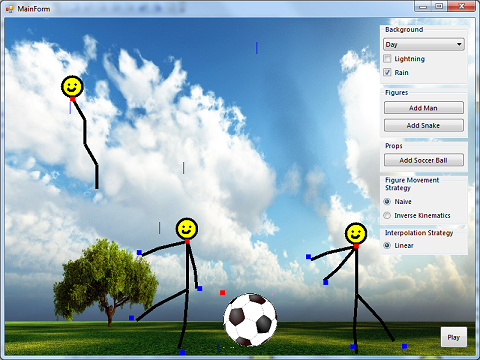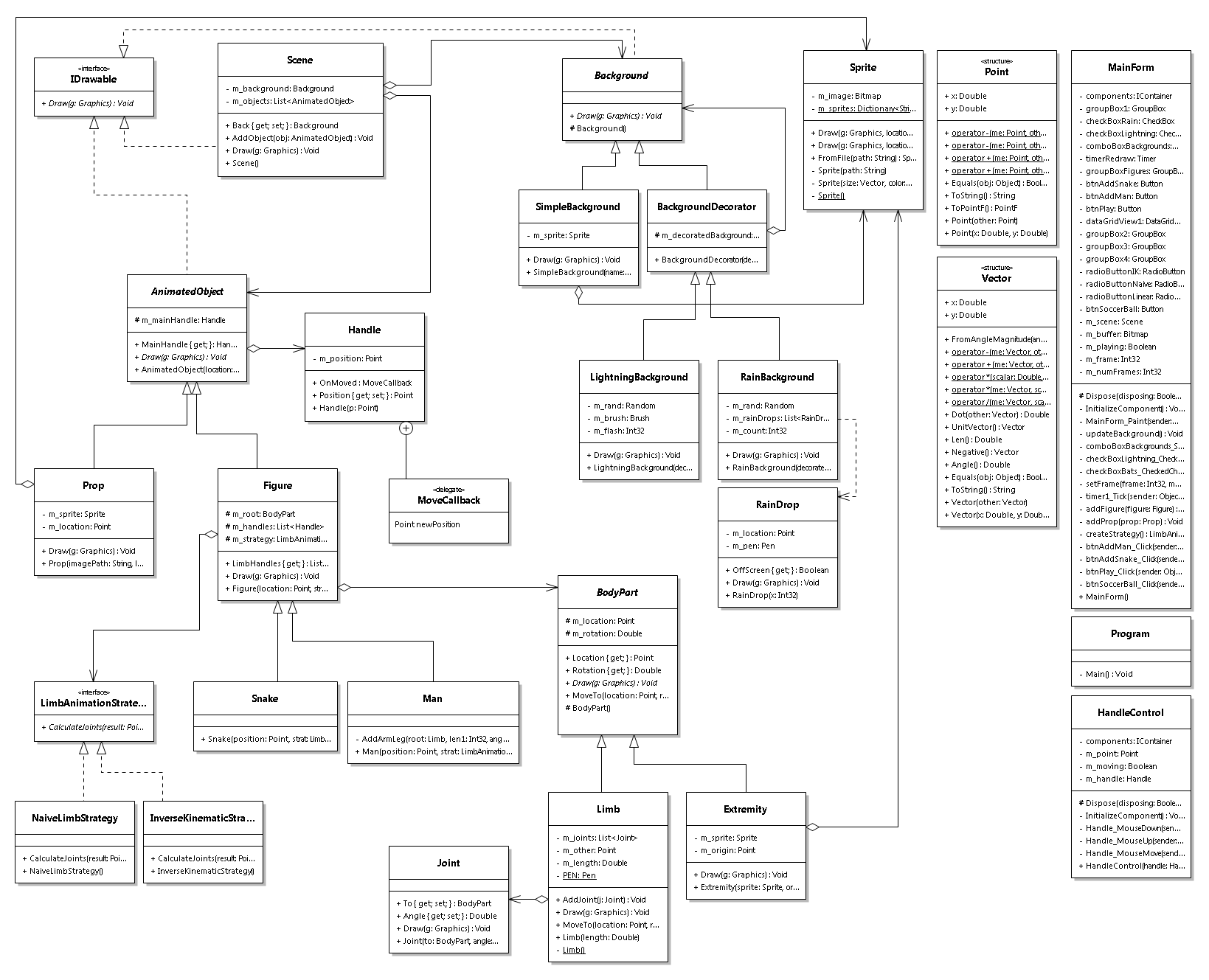User:Josh Oosterman/Design Study
| Line 37: | Line 37: | ||
=== Overview === | === Overview === | ||
| − | IDrawable '' | + | |
| + | The above UML diagram looks large, but the system is very simple and it should be easy to find your way around. | ||
| + | |||
| + | The far right classes ''MainForm'' and ''Program'' are for the .NET generated GUI for the application. This is not an important part of the OO design and is mostly ignored in the design study. Similarly, the ''Point'' and ''Vector'' classes next to it are geometry utility classes I have written, which will also be ignored in this study. | ||
| + | |||
| + | At the top left is the ''IDrawable'' interface. This defines just one method, but is used throughout the design. The Draw method takes a reference to a Graphics context. | ||
| + | |||
| + | At the top left we can see the ''Scene'' class. The scene class is just that - a scene in an animation. The application lets you use only one scene object, but it is not a singleton as it is feasible multiple scenes could be supported in the future. The ''Scene'' class consists of a background, and a collection of ''AnimatedObjects''. The ''Background'' of a scene could be a ''SimpleBackground'', optionally decorated with effect using the ''LightningBackground'' or ''RainBackground'' classes. ''RainDrop'' is a lightweight class used by the ''RainBackground'' decorator. The background classes can be seen in the top center of the diagram. The ordering of ''AnimatedObjects''in a scene is not important, but .NET 3.0 does not include a Set class so a ''List<AnimatedObject>'' was used instead. | ||
| + | |||
| + | The inheritance tree of ''AnimatedObject'' constitutes the left third of the UML diagram. The two subclasses of ''AnimatedObject'' are ''Prop'' and ''Figure''. A ''Prop'' represents a single solid object, such as a soccer ball (as seen in the screenshot above). Props have only a ''Sprite'' and a position. The ''Figure'' subclass is more complex, and is used to represent posable composite objects such as humans or animals. ''Figure'' is further explained below. ''AnimatedObject'' also uses a ''Handle'' object, accessible through its ''MainHandle'' property. The syntax "+ MainHandle { get; }" on the UML diagram represents a .NET property, equivalent to a getter method. | ||
| + | |||
| + | A ''Handle'' is used to position or pose an ''AnimatedObject''. The MainHandle handle is used to position the ''AnimatedObject'' within the scene. The ''Figure'' subclass has a further collection of handles, which can be used to move arms and legs, for example. The ''Handle'' class defines a delegate type and event called ''MoveCallback'' that is called when a handle is moved. The ''AnimatedObject'' can subscribe to this event and react. | ||
| + | |||
| + | |||
| + | |||
| + | Finally, the ''Sprite'' class can be seen near the top right of the diagram. A ''Sprite'' is a static image that can be used in the animation. Internally, it just wraps a .NET ''Bitmap'' object, but the interface does not depend on this. Sprites can be created by either loading an image file, or creating an empty image of a specified size and colour. The benefit of the Sprite class is to provide resource sharing, using the Flyweight design pattern. | ||
=== Interfaces, Inheritance and Encapsulation === | === Interfaces, Inheritance and Encapsulation === | ||
| Line 44: | Line 59: | ||
AnimatedObject heirachy ''ToDo'' | AnimatedObject heirachy ''ToDo'' | ||
| − | |||
| − | |||
=== Design Patterns === | === Design Patterns === | ||
| Line 57: | Line 70: | ||
''ToDo'' | ''ToDo'' | ||
| + | |||
| + | Object Encapsulation ''ToDo'' | ||
=== Maxims Violated === | === Maxims Violated === | ||
MVC etc ''ToDo'' | MVC etc ''ToDo'' | ||
Revision as of 09:35, 1 August 2010
Contents |
The Problem
I wanted to create a tool to animate scenes, and humanoid characters.
Eventually I want be able to create complex animations which can be loaded into a 2d game.
This would take too long for a 427 assessment, so I've simplified the problem to having an interactive stickmen tool. The extensibility of the design of the system is critical so I can extend it in the future.
The system was fully designed and implemented for COSC427, and was not based on previous work.
A screenshot of the current version is shown below.
System Goals
Within my 427 Project
- Customisable backgrounds
- Posable figures (Such as Stickmen)
- Props
- Extensible - so I can add the below features eventually
Outside the scope of this project, but to be added in the future:
- Interpolation between Keyframes
- Advanced Inverse Kinematics & Constraints on Joints
- Export angles & positions as animation file to be used in games
Code
The system was implemeted in C# and can be obtained here. To build and run is trivial -- Open Stickman.sln in Visual Studio and build. You'll need Windows and VS2008 or later.
System Design
The image below is a simplified UML class diagram of nearly all of the classes in the system.
Overview
The above UML diagram looks large, but the system is very simple and it should be easy to find your way around.
The far right classes MainForm and Program are for the .NET generated GUI for the application. This is not an important part of the OO design and is mostly ignored in the design study. Similarly, the Point and Vector classes next to it are geometry utility classes I have written, which will also be ignored in this study.
At the top left is the IDrawable interface. This defines just one method, but is used throughout the design. The Draw method takes a reference to a Graphics context.
At the top left we can see the Scene class. The scene class is just that - a scene in an animation. The application lets you use only one scene object, but it is not a singleton as it is feasible multiple scenes could be supported in the future. The Scene class consists of a background, and a collection of AnimatedObjects. The Background of a scene could be a SimpleBackground, optionally decorated with effect using the LightningBackground or RainBackground classes. RainDrop is a lightweight class used by the RainBackground decorator. The background classes can be seen in the top center of the diagram. The ordering of AnimatedObjectsin a scene is not important, but .NET 3.0 does not include a Set class so a List<AnimatedObject> was used instead.
The inheritance tree of AnimatedObject constitutes the left third of the UML diagram. The two subclasses of AnimatedObject are Prop and Figure. A Prop represents a single solid object, such as a soccer ball (as seen in the screenshot above). Props have only a Sprite and a position. The Figure subclass is more complex, and is used to represent posable composite objects such as humans or animals. Figure is further explained below. AnimatedObject also uses a Handle object, accessible through its MainHandle property. The syntax "+ MainHandle { get; }" on the UML diagram represents a .NET property, equivalent to a getter method.
A Handle is used to position or pose an AnimatedObject. The MainHandle handle is used to position the AnimatedObject within the scene. The Figure subclass has a further collection of handles, which can be used to move arms and legs, for example. The Handle class defines a delegate type and event called MoveCallback that is called when a handle is moved. The AnimatedObject can subscribe to this event and react.
Finally, the Sprite class can be seen near the top right of the diagram. A Sprite is a static image that can be used in the animation. Internally, it just wraps a .NET Bitmap object, but the interface does not depend on this. Sprites can be created by either loading an image file, or creating an empty image of a specified size and colour. The benefit of the Sprite class is to provide resource sharing, using the Flyweight design pattern.
Interfaces, Inheritance and Encapsulation
IDrawable ToDo
AnimatedObject heirachy ToDo
Design Patterns
- Strategy pattern (LimbAnimationStrategy) ToDo
- Observer (Handle) ToDo
- Flyweight (Sprite) ToDo
- Decorator (Background) ToDo
Maxims Followed
ToDo
Object Encapsulation ToDo
Maxims Violated
MVC etc ToDo

